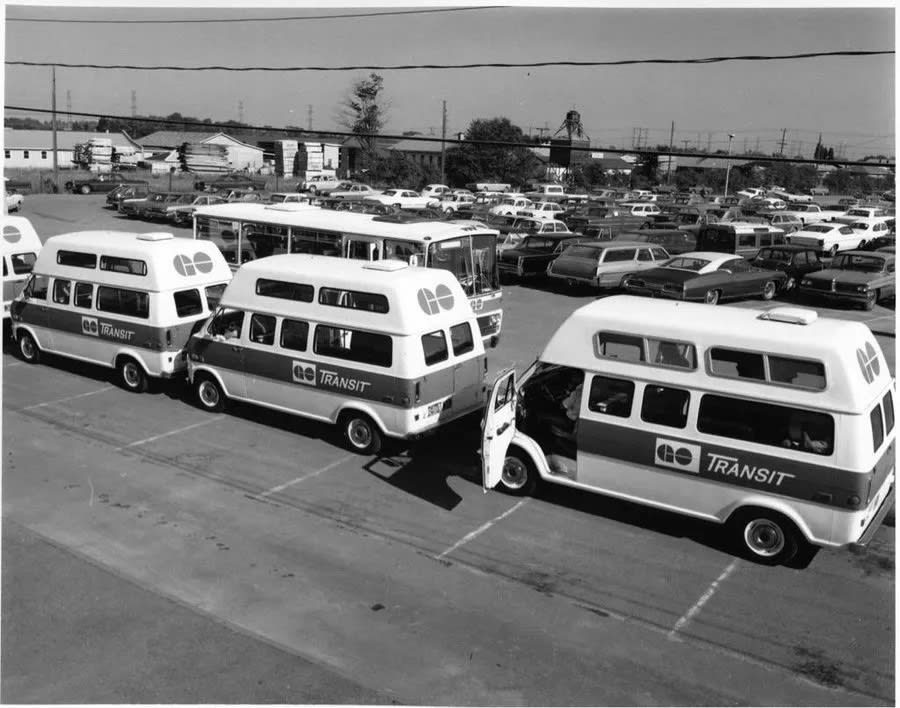Dialing Back in Time: GO’s Dial-A-Bus Service
In the 70s, GO pioneered a public transit service that would pick you up straight from your door.
Sep 16, 2020
Let’s hit reverse for a moment.
GO bus service marks a half-century of service right now. That’s a lot of change and journeys.
So many trips for so many people – to work and shopping and entertainment and even weddings.
So many stories that trace back 50 years, to our parents and perhaps grandparents.
But the first chapter was perhaps the most trend-setting and unusual for public transit in Ontario – the tale of a small trial project that ultimately evolved into the GO bus network that exists today.
It’s the ’70s, people are moving and on the go in Ontario.
There are huge cultural and economic shifts happening across Canada, and beyond.
Between 1971 and 1976 alone, the province’s population rose from 7.7 million to 8.2 million, with over 80 per cent of people settling in urban areas. They all had places to go and people to see.
With that in mind, GO decided to experiment with an on-demand minibus that would provide door-to-door service for commuters between their homes and select subway stations and plazas.
“Dial-a-bus was similar to the modern-day ride-sharing concept like Uber,” explains Dan Dell’Unto, a transit historian and photographer based in in Toronto.
He’s been following and capturing the evolution of transit vehicles over the years and says dial-a-bus was a system ideal for sprawling suburban areas where ridership demand for a fixed route bus was low.
“Imagine a GO double-decker full of passengers pulling up to your front door – it just wouldn’t be possible on a larger scale,” he says.
The concept was revolutionary at the time.
In October of 1973, GO launched the on-demand minibus service to provide door-to-door service to some neighborhoods that were divided into zones, each served by a single small bus.
For a fare of 35 cents, passengers were picked up and dropped off anywhere they wish within their zone, or taken to the city centre where they could transfer to another bus.
A GO Transit Ford Econoline passenger van operating in dial-a-bus service in the Pickering area in the early 1970’s. The service brought them to major transfer points and terminals such as malls, train stations, and transit terminals. (Metrolinx Photo)
All you had to do was place a call an hour before you had to travel.
From there, an Operator inside a central dispatch office would open a binder with a tracking sheet, write down your address, and takes down where you were going and how many passengers.
A look inside the central dispatch office where operators would take down customer information using a pen and binders. (Still image from the Ontario Archives short documentary People on the GO)
Next thing you know it, a brightly colored minibus would pull up in front of your door, often times a Ford Econoline passenger van or Rek-Vee Club Car – a motorhome reconfigured for transit.
The dial-a-bus drivers would wait and call the dispatch centre if you were a no-show, the centre would then call you to check in and let you know the bus had arrived.
This is the seating configuration inside a Dial-A-Bus. I was smaller than a traditional bus but bigger than an Uber XL. (Still image from the Ontario Archives short documentary People on the GO)
Accord to Dell’Unto, GO’s dial-a-bus service first operated in the Bay Ridges area in Pickering, and then it began in North York, Bramalea (pre-Brampton amalgamation) and Mississauga. It was novel concept and was ultimately the stepping-stone to more permanent and higher-capacity fixed-route transit operations.
Dial-a-bus service ran six days a week until 1976.
But the history of the GO bus doesn’t stop there.
As demand for GO Bus services grew, so did its fleet and number of terminals. To meet this demand, GO launched new services including bus service timed to the arrival of GO Trains – making connections easier.
To learn more about Dial-A-Bus and how it operated; check out this interesting video that captures the program, along with the feeling of the times.
And stick with us in the coming weeks, as we explore more of the 50 year history of GO bus.
by Nitish Bissonauth Metrolinx bilingual editorial content advisor
